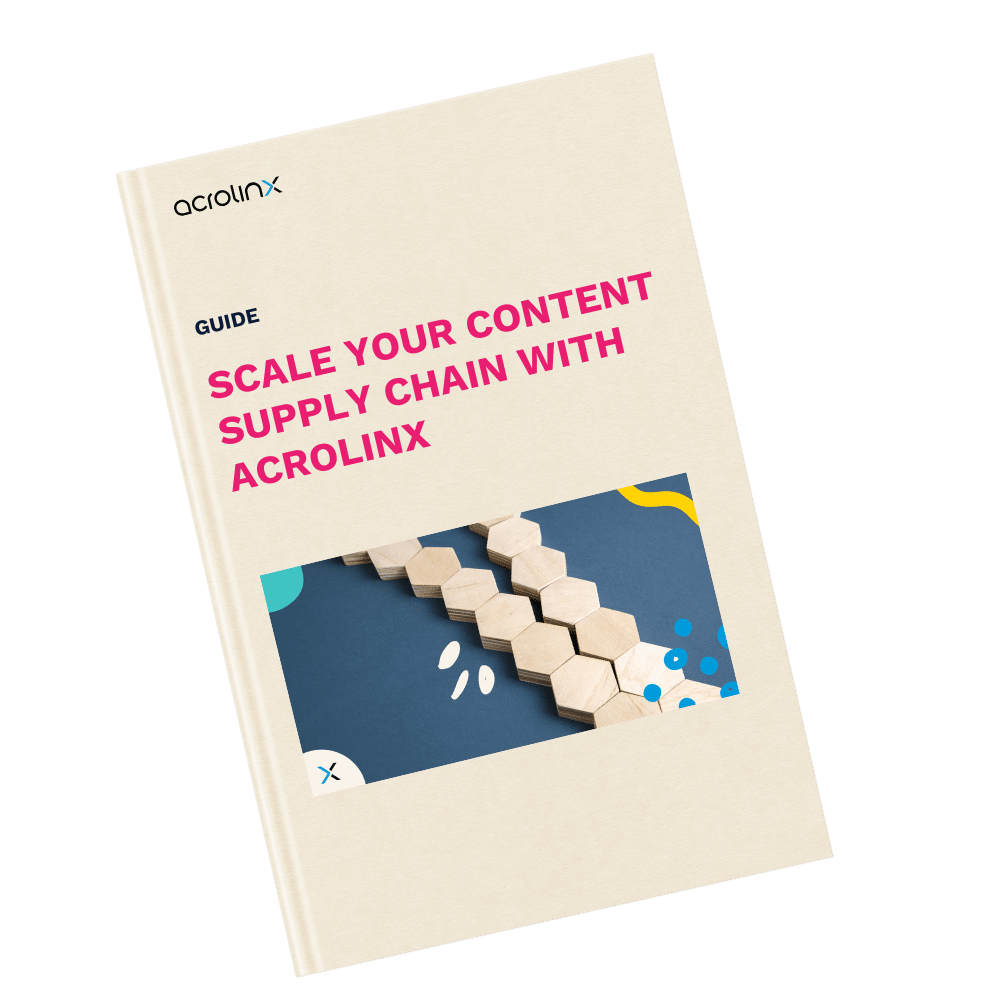Creating Content at Scale: A Roadmap for Successful Global Content Governance

Creating content at scale while maintaining quality, consistency, and compliance is a long-standing enterprise challenge.
Even though the rise of great AI tools is streamlining content production, the challenge remains. To keep up with their competition, enterprises need to create more content, faster. At the same time, compliance, accuracy, and consistency matter more than ever before.
A strong global content governance strategy solves this challenge. It helps businesses communicate effectively with various international audiences all while aligning content with your enterprise’s goals. With AI-powered tools and structured workflows, your enterprise streamlines the content creation process across your content supply chain. The result? Improved localization efforts and a unified brand identity across multiple markets.
What are the elements of global content governance? And what are the concrete steps you can take for creating content at scale? Let’s start by diving into the concepts of global content governance and content at scale.
Learning the essentials
What’s global content governance?
Global content governance refers to the structured processes, policies, and technologies that enterprises use to manage content creation, localization, and distribution at scale. By offering writing guidance and automated content checks based on your writing rules, it makes sure that content remains consistent, compliant, and aligned with brand identity across all global markets. By implementing a governance framework, your business mitigates risks, streamlines content production, and maintains quality standards regardless of geographic or linguistic differences.
Essential elements of global content governance
Content strategy alignment
How do you make sure that all content aligns with your business objectives, target markets, and audience preferences? First define your core messaging, tone, and standards for consistency. Use this as a foundation for a global content strategy that maps your content expectations into actionable guidance for your writers.
A well-structured content strategy lays the foundation for effective communication. By defining not only what to write about, but how to communicate with the target audience, it makes every piece of content serve a strategic purpose while addressing the reader’s needs.
Content standardization
Creating clear content guidelines is essential. These guidelines need to include brand voice examples, approved and deprecated terminology, and writing style guidance. They help keep things clear and consistent in different regions. A strong style guide results in content that easily translates and adapts to local needs.
When you use a unified set of writing and formatting rules, your content maintains consistent tone and messaging across various languages and channels.
Regulatory compliance
Content must follow industry regulations, accessibility requirements, and localization laws in different markets. Compliance tools help safeguard these legal and ethical obligations while maintaining content accuracy. In highly regulated industries like financial services, life sciences, and manufacturing, compliance with regulatory frameworks is critical to mitigating risks and maintaining customer trust.
AI-powered content optimization
AI-powered tools assist in checking content quality, readability, and consistency. These tools enable your enterprise to automate content audits and align messaging with brand standards. By using AI-powered analytics, you can improve content performance, and refine tone and style. AI tools make sure every piece of content meets brand guidelines — while reducing manual effort and improving efficiency.
Translation and localization
Effective global content governance includes strong translation and localization strategies. This involves not only translating words but also adapting content to fit cultural nuances, audience expectations, and regulatory requirements. High-quality, culturally relevant translations help your enterprise build trust with local target audiences and improve engagement in international markets.
Content performance analytics
You need evidence-based insights to evaluate the effectiveness of your content. By tracking engagement metrics, you can refine your strategies and improve content performance over time. Analyzing key performance indicators such as user engagement, readability scores, and conversion rates enables you to make informed decisions. Based on these decisions, you can continuously improve the performance of your content.
Collaboration and workflow management
A structured content workflow fosters collaboration between global teams. Your enterprise should establish roles, responsibilities, and approval processes to maintain efficiency and consistency across content production cycles. Effective workflow management reduces bottlenecks, improves content quality, and makes sure that content meets brand and regulatory standards before publication.
What does it mean to create content at scale?
Creating content at scale refers to producing a high volume of content efficiently while maintaining quality, consistency, and alignment with business objectives. This process involves an enterprise’s whole content supply chain. It covers aspects like automation, AI-powered insights, and governance frameworks to meet increasing global content demands without compromising accuracy.
Tips for creating content at scale
When scaling content production, you must embrace technology, collaboration, and performance insights to maintain quality and consistency.
Fundamental area Description Automation and AI tools AI writing tools, automated quality checks, and content management systems streamline content production and make content follow the brand guidelines. Content reuse Instead of creating new content from scratch, you can improve existing content by reusing and localizing it for different markets. Global market adaptation Content must be adaptable for diverse international markets. This requires in-depth global audience research and strong localization strategies. Cross-department collaboration Successful content scaling requires collaboration between marketing, product, compliance, and localization teams to maintain consistency across platforms. Performance tracking Using analytics tools like Google Analytics, you can monitor global audience engagement, track content effectiveness, and refine strategies to improve performance. With content governance solutions like Acrolinx, it can even link performance analytics to content quality metrics for more insights.
To navigate you through the process of creating content at scale, we’ve created a roadmap for you. It’s time to learn how to successfully manage global content production at scale.
Your roadmap to creating content at scale
Scaling content production while maintaining consistency, compliance, and quality requires a structured approach. This roadmap will guide you through the essential steps to successfully manage global content creation. From establishing a scalable global strategy to using AI to achieve efficiency and compliance across markets.
Follow these steps to streamline workflows, improve content performance, and build a strong global brand presence.
Step 1: Laying the foundation — a scalable global content strategy
Creating content at scale requires a well-defined global content strategy that aligns with your enterprise’s business goals. Without a structured approach, content creation efforts can become fragmented. Subsequently, this leads to inconsistencies in messaging, tone, and brand identity across different markets.
A comprehensive global content strategy helps create content that aligns with your brand’s core values and the expectations of a diverse international audience. It provides a roadmap for standardizing content guidelines, setting multilingual content standards, and adapting messaging for different markets while maintaining a strong global brand presence.
Successful global content marketing starts with thorough market research to understand audience preferences, cultural differences, and language specifics. For content that resonates with a global audience, focus on creating your brand voice, style guidelines, and a structured content calendar for global content efforts.
How content governance software helps
Content governance software provides the foundation for building and enforcing a global strategy that aligns with business objectives and adapts to regional market needs.
- Defining and enforcing content standards: Governance software digitizes style guides, tone of voice, and terminology rules. This is how it ensures that every content piece aligns with corporate messaging. This helps create a consistent foundation for content strategy across all markets.
- Achieving compliance from the start: A strong content strategy must account for regulatory and accessibility requirements. Governance tools automatically check content against industry regulations, making compliance an integral part of the creation process rather than an afterthought.
- Tailoring content to global audiences: Effective content strategies require localization readiness. Governance software analyzes content for clarity, simplicity, and cultural adaptability. It increases translatability which means that content resonates with diverse audiences.
- Providing data-driven insights: Teams build successful content strategies based on measurable results. Content governance platforms offer analytics on content quality, consistency, and engagement. This enables you to refine your strategy based on real performance data.
- Streamlining workflows and collaboration: Content strategies often break down because of silos and inefficiencies. Governance software integrates with existing authoring tools, guiding content creators as they write, and standardizing workflows across teams and regions.
By embedding governance directly into content strategy development, your enterprise will make sure that your global messaging is well-structured, scalable, and effective from the beginning.
Step 2: Using AI for consistent and high-quality content at scale
Scaling global content production without sacrificing quality is one of the biggest challenges global enterprises face. AI-powered content creation tools streamline content workflows by automating repetitive tasks, such as grammar checking, keyword research, and adjusting content formats for different platforms.
AI writing tools improve the content creation process by providing intelligent suggestions that align with enterprise content guidelines. These tools help make sure that all content types remain consistent in tone and style, regardless of the target market.
To maintain high-quality content while scaling, your enterprise should use AI-powered analytics to track engagement metrics and refine their content strategy over time. This allows you to adapt content dynamically to meet the evolving needs of diverse target markets while maintaining brand consistency.
How content governance software can help
Unlike many basic AI writing tools, content governance software combines crucial features for scaling content into one tool. From digitizing style guides, to writing support during content creation all the way to post-publication metrics.
As a content governance solution, Acrolinx integrates live content quality assurance directly into writing tools. Here, writers not only see content issues. They receive AI-powered suggestions on how to fix them with only one click. This allows them to create high-quality content without enormous efforts, providing room to scale.
Step 3: Following compliance and industry standards in global markets
Compliance with industry regulations, accessibility standards, and localization requirements is critical for businesses operating at a global scale. Not meeting regulatory standards leads to costly fines, reputational damage, and loss of customer trust.
Content compliance tools help you follow legal requirements by automatically scanning content for readability, inclusivity, and regulatory alignment. These tools make sure that product documentation, customer-facing content, and marketing materials meet the necessary legal and ethical standards for different industries and regions.
A case study example
A financial services enterprise faced challenges in meeting Consumer Duty compliance. By implementing AI-powered content governance, the enterprise improved content clarity, achieved accessibility for local audiences, and mitigated compliance risks across global markets.
Step 4: Achieve global success with high-quality translation
Excellent translations are important to global success. Sure, many people worldwide speak English as a first or second language. But 76% of global consumers prefer products that come with documentation in their own language — as a consequence, enterprises should make sure to offer multilingual content.
AI tools for translation help your enterprise scale its translation processes.
But just having content in a target language isn’t enough: You want it to build meaningful connections with potential customers worldwide. At the same time, you need to comply with global and regional content regulations.
This makes high-quality, easy to translate source content essential for every global enterprise.
Improving translation with content governance software
Content governance software like Acrolinx plays a crucial role in improving translations by making sure that source content is clear, consistent, and localized for global audiences. Here’s how:
- Terminological consistency: Acrolinx enforces consistent use of approved terminology across all content, reducing ambiguity and ensuring accurate translations.
- Simplified sentence structures: Clear, concise writing is easier to translate and minimizes the risk of errors in localization.
- Readability and clarity: AI-powered content guidance helps writers create content that’s free from jargon, overly complex phrasing, or regionally specific idioms that may not translate well.
- Compliance with global standards: With Acrolinx, content meets industry-specific regulations, making translations more reliable and compliant with global and regional requirements.
- Improved translation memory efficiency: When source content is consistent and high-quality, translation memory systems work more effectively, reducing costs and improving translation speed.
By using Acrolinx, you optimize your source content for global success. The result: Faster, more accurate, and cost-effective translations.
Step 5: Boost content governance to its fullest by using automation
Even the most well-defined global content governance strategy can struggle to scale without automation. As enterprises produce vast amounts of content across multiple teams and channels, manual reviews become inefficient. Subsequently, this leads to inconsistencies, compliance risks, and reduced content quality.
By incorporating automation, you enforce governance at scale. It makes sure every piece of content meets brand, regulatory, and linguistic standards before publication.
Automating content governance with Acrolinx
Acrolinx provides automation features that help enterprises maintain high-quality, consistent, and compliant content at scale:
- Batch checks for enterprise-wide content analysis: Instead of manually reviewing content piece by piece, Acrolinx’s batch checking feature allows enterprises to analyze multiple documents, webpages, or repositories at once. This automation provides an overall view of content quality across the enterprise, identifying areas for improvement and making sure all content aligns with corporate guidelines.
- Quality gates for compliance-driven workflows: Quality gates act as automated checkpoints within content creation workflows. Before content moves to the next stage — whether for approval, localization, or publication — Acrolinx makes sure it meets predefined quality and compliance criteria. This prevents low-quality or non-compliant content from reaching customers, reducing risk, and maintaining brand integrity.
The impact of automation on content governance
By integrating automation into content governance, you gain:
- Scalability: Automation enables content teams to uphold governance across thousands of assets without increasing the manual workload.
- Efficiency: Content creators receive immediate guidance, reducing the need for extensive rewrites or post-production edits.
- Compliance assurance: Automation enforces regulatory and brand guidelines at every stage of content production, minimizing risks.
- Data-driven improvement: Automated insights help teams continuously refine their content strategy based on measurable quality metrics.
With Acrolinx’s automation capabilities, you transition from reactive content governance to a proactive, scalable approach — maintaining content quality, compliance, and consistency at every touchpoint.
Step 6: Measuring success — scaling without sacrificing quality
Expanding content production without compromising quality is one of the biggest challenges for enterprises. As teams scale, maintaining consistency, clarity, and compliance across a growing volume of content becomes increasingly difficult. Without a way to measure content quality, you risk diluted messaging, regulatory non-compliance, and ineffective communication.
Acrolinx provides a data-driven approach to content governance, enabling enterprises to measure, analyze, and improve the performance of their content at scale.
Important metrics for content quality and effectiveness
Acrolinx helps your enterprise track and improve content performance through:
- Content quality scores: Acrolinx assigns a measurable score to content, evaluating clarity, consistency, tone, terminology adherence, and compliance with brand guidelines. These scores provide a clear benchmark for assessing content quality across teams and departments.
- Enterprise-wide analytics and dashboards: Through advanced reporting, Acrolinx provides valuable insights. Multiple dashboards allow content leaders to monitor trends, pinpoint quality gaps, and track improvements over time. This visibility makes sure that content governance strategies remain effective as production scales.
- Comparative insights across teams and markets: Acrolinx enables you to compare content performance across different teams, regions, and languages. It makes sure that global content always meets the same high standards.
- Helpful recommendations for continuous improvement: Instead of just identifying problems, Acrolinx provides AI-powered clickable suggestions to improve content quality at every stage of the creation process. Teams can proactively adjust their strategies based on live feedback.
With Acrolinx’s measurement and analytics capabilities, you gain full visibility into content quality — allowing you to scale operations without sacrificing the precision, clarity, or compliance that their brand demands.
Global content governance: A scalable approach for success
Scaling content production while maintaining consistency, compliance, and quality requires a structured approach. Enterprises that implement AI-powered tools and governance frameworks can efficiently manage global content creation, ensuring alignment with brand identity and regulatory requirements.
To successfully create content at scale, enterprises must:
- Develop a scalable content strategy: Align content creation with business objectives, ensuring a unified brand voice across diverse markets.
- Use AI for efficiency: Automate quality checks, content improvement, and multilingual adaptation to maintain consistency at scale.
- Follow compliance and industry standards: Use governance tools to meet regulatory requirements and mitigate risks in highly regulated industries.
- Improve localization and translation: Adapt content for global markets by considering cultural nuances and audience preferences, improving engagement and accessibility.
- Monitor and improve performance: Implement evidence-based insights to refine content strategies, track engagement, and continuously improve effectiveness.
By embedding governance into every step of the content lifecycle, you create high-quality, compliant, and globally resonant content at scale. A well-executed global content governance strategy not only streamlines workflows across the content supply chain but also strengthens brand credibility and market presence worldwide.
With the right tools and approach, businesses can confidently navigate the complexities of content at scale and achieve meaningful engagement. Download our guide and learn more about scaling your content supply chain for global success.
Are you ready to create more content faster?
Schedule a demo to see how content governance and AI guardrails will drastically improve content quality, compliance, and efficiency.

Hannah Kaufhold
is a Senior Marketing Manager at Acrolinx, with over ten years experience in content strategy and content creation. They hold a Master’s degree in linguistics. Hannah has a strong interest in controlled languages and terminology and is passionate about diversity and inclusion. In their free time, they enjoy spending time with their family and reading.





